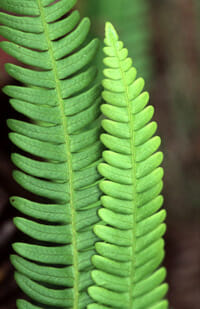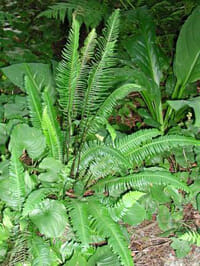Deer Fern – Polypodiales Polypodiaceae Blechnum spicant
 |
 |
Identification & Description:
Deer Fern (Blechnum spicant) Very common understory on upland prairies, less common in forest understory. Two types of fronds occur on these fern. Sterile fronds are perennial, growing in radial pattern from rhizomes with pairs of leathery leaflets. One to three fertile fronds are deciduous, growing vertically from center of clump with smaller leaflets and rolled margins. Growth forms, especially size, are different between forest and prairie. Forest deer fern are typical of the species, with fronds 20-120 cm long, 35-70 pairs of leaflets on each frond, with leaflets 1-5 cm long. These fern look similar to Sword Fern. Deer fern on the prairies are very stunted. Fronds are less than 20 cm long, often less than 10 cm with 10-20 leaflet pairs less than 2 cm long.
Physical Characteristics
An evergreen fern growing to 0.3m by 0.3m at a slow rate. It is hardy to zone 5. It is in leaf all year, and the seeds ripen from June to August. We rate it 2 out of 5 for usefulness.
The plant prefers light (sandy), medium (loamy) and heavy (clay) soils, requires well-drained soil and can grow in heavy clay soil. The plant prefers acid and neutral soils and can grow in very acid soil. It can grow in full shade (deep woodland) semi-shade (light woodland) or no shade. It requires moist soil.
Edible Uses
Leaves; Root.
Root – cooked. An emergency food, used when all else fails.
Young shoots (often called croziers) – cooked. The young tender stems can be peeled and the centre portion eaten. An emergency food, it is only used when all else fails. It is also chewed to alleviate thirst on long journeys.
Other Uses
Ground cover.
A good ground cover plant. Relatively slow growing but succeeding in the dense shade of trees.
Cultivation details
A calcifuge plant, it prefers a moist shady nook in the rock garden or a position in open woodland in a moist soil. Succeeds in quite dense tree shade if the soil is moist. Prefers a moist position and a northerly aspect but succeeds in sun and in clay soils.
A polymorphic and very ornamental species, there are several named varieties.
Members of this genus are rarely if ever troubled by browsing deer.